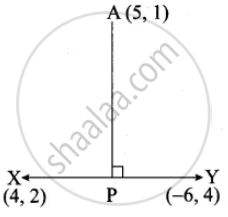Advertisements
Advertisements
Question
What is the slope of a line perpendicular to the line joining A(5, 1) and P where P is the mid-point of the segment joining (4, 2) and (–6, 4).
Solution
Mid-point of XY = `((x_1 + x_2)/2, (y_1 + y_2)/2)`
= `((4 - 6)/2, (2 + 4)/2)`
= `((-2)/2, 6/2)`
= `(– 1, 3)`

Slope of a line = `(y_2 - y_1)/(x_2 - x_1)`
= `(3 - 1)/(-1 - 5)`
= `(2)/(-6)`
= `(-1)/3`
Slope of the line ⊥' to AP = `(-1)/"slope of AP"`
= `(-1)/(-1/3)`
= 3
APPEARS IN
RELATED QUESTIONS
What is the inclination of a line whose slope is 1
Find the slope of a line joining the points
(sin θ, – cos θ) and (– sin θ, cos θ)
Show that the given points are collinear: (– 3, – 4), (7, 2) and (12, 5)
The line through the points (– 2, 6) and (4, 8) is perpendicular to the line through the points (8, 12) and (x, 24). Find the value of x.
Show that the given points form a right angled triangle and check whether they satisfy Pythagoras theorem
A(1, – 4), B(2, – 3) and C(4, – 7)
Show that the given points form a parallelogram:
A(2.5, 3.5), B(10, – 4), C(2.5, – 2.5) and D(– 5, 5)
Let A(3, – 4), B(9, – 4), C(5, – 7) and D(7, – 7). Show that ABCD is a trapezium.
A quadrilateral has vertices at A(– 4, – 2), B(5, – 1), C(6, 5) and D(– 7, 6). Show that the mid-points of its sides form a parallelogram.
If slope of the line PQ is `1/sqrt(3)` then slope of the perpendicular bisector of PQ is
Without using distance formula, show that the points (−2, −1), (4, 0), (3, 3) and (−3, 2) are vertices of a parallelogram
